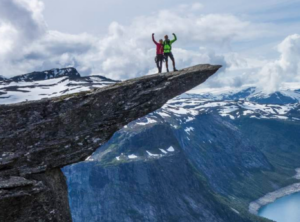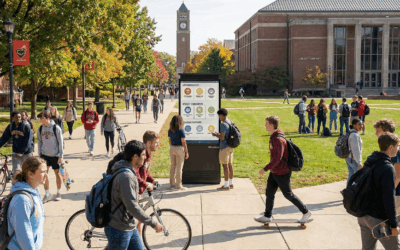Last week the HootBoard team packed up our blue t-shirts, our stacks of flyers, our branded pens, and a boatload of candy and headed out to St. Louis to take part in the annual Destinations International conference. Each year DI brings together destination marketing organizations from around the country (and even a few international visitors!) to take part in continuing education courses and discuss the latest trend. This was our first year at Destinations International but we excited by how much the conference had to offer and how much we were able to learn from our destination marketing allies.
As newcomers to the conference, we’ve pulled together some of our key takeaways and learnings to share:
53% of millenials plan numerous “micro trips” throughout the year instead of one big trip.
This means drive in markets are becoming increasingly more important in destination marketing. ? ? #pcma #ac19stlouis #cheerstotheweekend pic.twitter.com/XMNeaCgc0z— Katie Dolan (@OttawaKD) July 24, 2019
Short Trips are Becoming More Popular
Many travelers are planning short trips throughout the year compared to the previous trends of doing one or two long trips each year. As Katie from Ottawa observed, this means drive-in markets are becoming increasingly more important from a marketing standpoint.
Our take: Short trips means less advanced planning. Travelers are booking a ticket and lodging and are good to go. All the destination activity planning is happening in-destination. This is a tremendous challenge and an opportunity for the right in-destination engagement experience.
Information Gathering is Still a Challenge for Visitors
Even though we live in a highly connected world and we’re nearly always online through our mobile phones, visitors still struggle to find reputable information when they need it. As marketers, we’ve focused on getting visitors into our destinations but trends are changing and many visitors are planning trips on the fly once they arrive. This means fewer bookings are done at home and DMOs and local businesses are faced with a new challenge – how do you reach visitors when they’re making an off the cuff decision to book their day’s tours, attractions, or reservations? How do you make the most of a visitor’s time when they are in-destination and make sure they’re getting the most out of their visit? How do destinations ensure that the visitor will speak highly of the trip when they return home? These crucial questions are driving DMO decisions and spend but are a new challenge that we all face.

photo courtesy of www.VisitNorway.com
Overtourism is Real and Very Painful
@signexina gave this example of Trolltunga rock in Norway: in 2009 it had only 500 visitors but thanks to some amazing social media pictures, that number had grown to 40,000 by 2014. Overtourism is real and it’s happening all over. In fact at the Destinations International, it was one of the main challenges discussed.
Our take: A Traveler’s reliance on social media and the top things to do listicles could be feeding this. Listicles are a great way to get Google rankings and might be hard to take away from the DMO toolset but can this be augmented by UI nudges like the smart discovery of local attractions? Can digital in-destination discovery tools showcase a different picture and help people find attractions and activities in real-time?
@Signexina is calling for the end of tourism and a shift to #localhood. No one wants to be a tourist. Each traveler is unique and looking for an experience as explorers and adventurers. Helping them find new ways to enjoy destination is solution to #overtourism. #AC19StLouis pic.twitter.com/nliJEWIKnu
— JT Long (@SmartMtgsJT) July 24, 2019
The Travel Experience Should Be Local
More and more, visitors are looking for a local experience when they travel. Now, this doesn’t necessarily mean they want to stay close to home but instead that they’re looking to get off the beaten path. They will, of course, visit your destination’s most famous tourist attraction but they’re also looking for that hidden gem of a breakfast place or the next big thing when it comes to a boutique hotel. Today’s travelers don’t want a canned experience handed to them out of a package tour, they’d rather experience the best-kept secrets that your region has to offer so they can feel like they found something special.
Our take: Getting off the beaten path path, driving #localhood and making tourists feel like #temporarylocals is much easier said than done. Destinations are asking how do we bring visitors into the fold without overhyping our best-kept secrets? How do we create custom experiences for each traveler while still driving foot traffic to our already bonafide attractions? Can you provide enough variety with printed materials?? Can you educate your visitor center staff often and on time? Or does in-destination digital information finding offer the right way to do this?
The Shift from Marketing to Managing
This need for information while in-destination and the focus on local experience are also driving a change for destination professionals and their partners. Where dollars used to be focused solely on driving visitors to the market, DMOs are now morphing into DMMOs with dollars and time being allocated to engaging visitors in-destination as well as in the pre-visit stage. Whether they’ve added actual team members or are asking for more from the current team, this was a common theme in nearly all of our conversations at Destinations International. Heads in beds isn’t enough anymore – destinations want to ensure that each visitor is having the best experience they can while visiting.
Our take: Making the shit from just marketing to Marketing & Management is not easy. DMOs will not be able to invest enough money on their own to create attractions and spaces. They will face personnel challenges as well as operational challenges in keeping up with data gathering to identify and highlight the ever-changing “off the beaten” path experiences within their region.
DMOs, however, can exert influence. They can define what their unique destination experience means to their visitors. They can identify overtourism and other challenges and they can propose solutions, technologies, and partnerships to address these challenges.
Local Partnerships Matter Even More
The good news is that most DMOs understand that many hands make light work and are eager to bring on partners that will help address these challenges. Ultimately, we all have the same goal in mind – to help visitors make the most of their travels and their time in-destination. We all want to create experiences that surpass the expectations of visitors and keep them coming back for more. We want to create more stories that can be shared over coffee or drinks and drive more shared experiences between travelers. At its core, this is the vision that created HootBoard as a company and we were so thrilled to see it mirrored back to us in so many of our visitors last week. We love to help our customers share their stories and to help visitors find their way – and we love to help destinations build their ideal visitor experience.
Thank you to Destinations International and Explore St. Louis for hosting HootBoard and all of the fantastic DMOs last week and if you happened to stop by our booth – thank you for taking the time to say hello!
***
Learn more about HootBoard’s Destination Solution, sign up for a free demo or contact us for more information.




